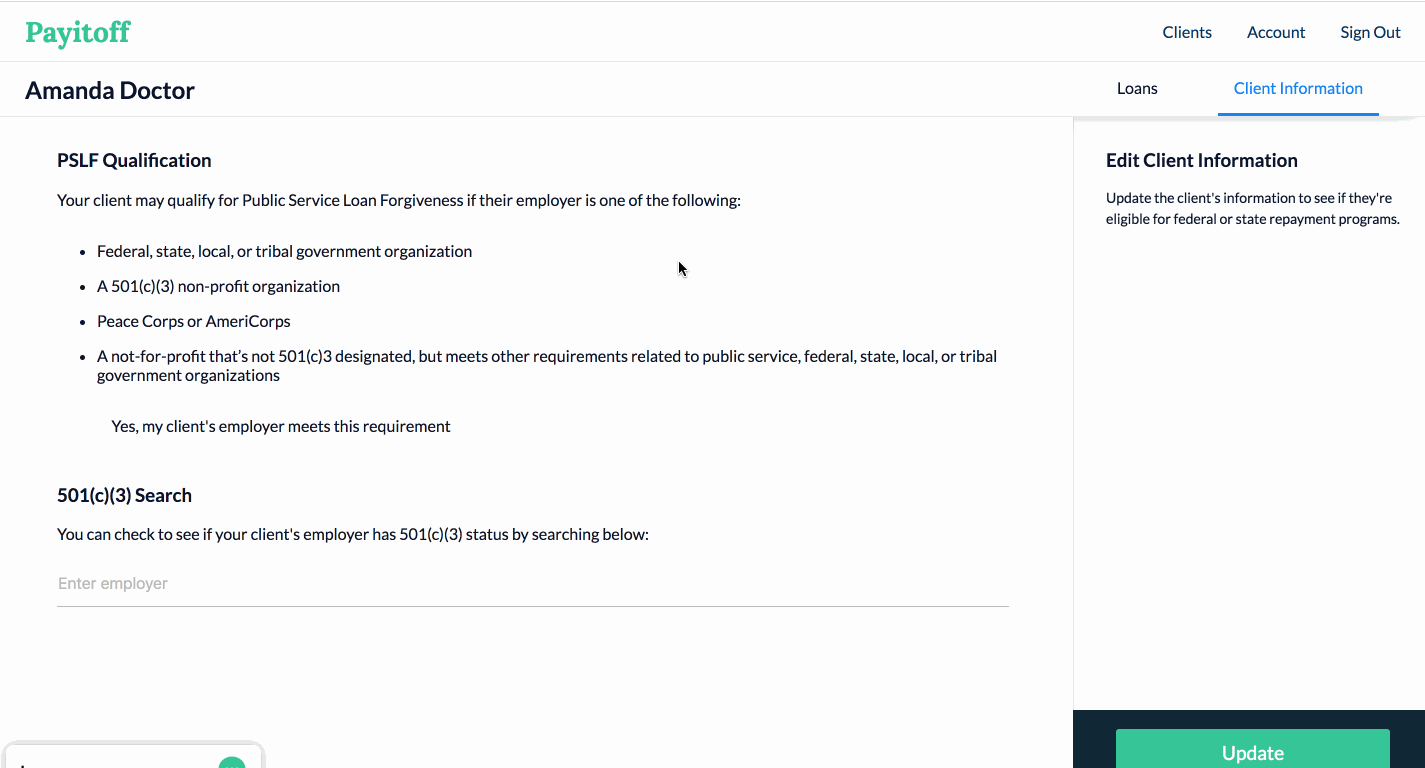PSLF In A Nutshell
The Public Service Loan Forgiveness program is a federal program where a student loan borrower gets tax-free loan forgiveness if they:
have Direct Loans
work full-time at a qualifying employer* for 120 months in repayment
are on an income-driven repayment plan**
Let me be clear: PSLF is NOT a repayment plan!
It’s a special program layered on top of an already-complicated repayment process for student loans. After 120 cumulative payments any outstanding interest is capitalized, attached to the outstanding debt and forgiven tax-free.
This can result in huge savings for heavily burdened clients, especially new doctors, dentists or lawyers.
As mentioned, the 120 payments don’t need to be consecutive at all! They can spend a year at a private sector job, then return to public service and finish the PSLF program.

When to PSLF
Public Service Loan Forgiveness comes up a lot for financial advisors using Payitoff. Often, their clients are deciding whether it makes sense financially to work in the public sector for 10 years or pursue alternative career options.
This is an incredibly important life decision.
You’ll want to consider PSLF for the following cases:
Your client is considering a job in the public sector with a slight pay cut
Your client is already in public service and is in repayment
How to PSLF
If you’re planning to have your client pursue PSLF, there’s two ways to ensure a positive outcome.
1. Every year, they need to fill out the Income-Driven Repayment Plan Request Form a month before the due date to re-certify their income. If they miss the deadline — one year from submission date — their interest will capitalize!
2. They should submit the Public Service Employment Certification Form. This isn’t required, but is extremely useful in confirming all their payments qualify each year.
#2 should also happen any time they switch employers.
Once they’ve hit the 120 payment mark, there’s a third form which actually asks the government to forgive the burden.
If you’re unsure whether your client’s employer is a qualified 501(c)(3), you can search directly within Payitoff. Check it out:

Ain’t Got Direct Loans
Unfortunately, only payments made on Direct loans will count towards that 120 total. There’s another group of loans called Federal Family Education Loans (FFEL) which were very common pre-2010. If your client has FFEL loans, they can still qualify for Public Service Loan Forgiveness by doing a Direct Consolidation.
Warning!! If your client is partially through income-driven repayment with their FFEL loans, a Direct Consolidation will reset the forgiveness clock.
For example, if they are halfway through the Income-Based Repayment Plan (yes, this is different than IDR) and they consolidate, they will start from zero for their forgiveness term. Any payments made prior to the consolidation will no longer count.
The Future of PSLF
PSLF doesn’t appear to be going anywhere. All of the bills currently circulating Congress support grandfathered PSLF candidates. If your client is on track for PSLF, the government can’t legally pull the rug out from under them. PSLF is literally on the Master Promissory Note.
That said, in my view PSLF is not exactly a sustainable program — don’t expect it to last forever.
I hope this has been helpful! In a future post, I’ll be discussing the recent data around PSLF and dive into the lesser known Temporary Extended Public Service Loan Forgiveness Program.
*A qualifying employer is considered to be:
Any federal, state, local, or tribal government organization
A 501(c)(3) non-profit organization
Peace Corps or AmeriCorps
A not-for-profit that’s not 501(c)3 designated, but meets other requirements related to public service, federal, state, local, or tribal government organizations
**All income-driven plans qualify, as well as the 10-year Standard Repayment Plan. However, it makes zero sense to be on Standard Repayment since the loans will be paid off by the time they’d be forgiven.
